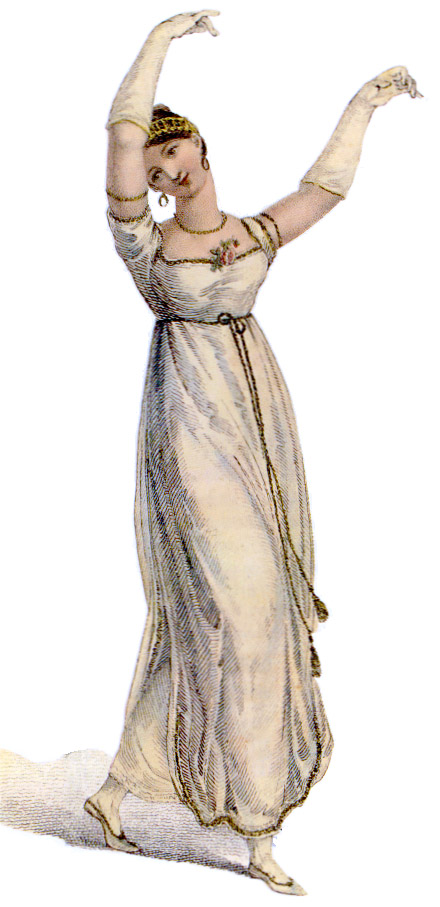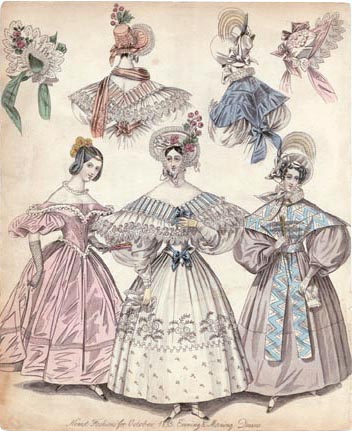One of the things that I researched for the Impertinent Daughters series was how the fashion had changed since the Regency Era. Regency Era fashion was defined by its long, columnar shapes and high waists.

The Victorian Era had several different fashion silhouettes which have become iconic and are easily spotted: the wide skirts made by many petticoats and crinolines, and the bustles later in the century.


Many have wondered how fashion went from a statuesque ideal to volumous skirts. Well, for the two decades from Waterloo to Victoria, there was the sentimentality of the Romantic Era. Marked by puffy sleeves in the 1820s, the waist began to return to its natural state, and skirts became more bell-like.
1821
1823

1825

1829

1829 fashion plate

By the end of the decade, the shoulder line is exaggerated and the sleeves are growing wider, known as gigot. Pleating was a common technique to contain the extra volume needed for the sleeves. Daytime gowns often included wide pelerine collars made of lace. Evening gowns were now off the shoulder. Stays were still worn and many heavily startched and/or corded petticoats were required to gain the appropriate volume on the bottom.
The sleeve widths were supported by “plumpers” stuffed in the gowns. Between the wide sleeves and the wide skirts, an optical illusion is created making waists look smaller. Gowns of the era often included belts to also emphasize the waist.

1830 fashion plate
1831

1833 fashion plate

1835

By the end of the 1830s, sleeves could no longer grow wider and instead drooped down.
1836-1840

1834-1839

1839

By the mid-1840s, the sleeves begin to take on an open bell or pagoda shape which would feature heavily in the 1850s and 1860s.
1844


The Romantic Era gowns often meets with criticism in the present world. However, contemporaries of the time also noted the difficulties with the attire.
It took some time for me to come around, but now I quite like the style of the Romantic Era. What do you think?
More information:
Follow Rose’s Pinterest Board: Romantic Era fashion
Mimi Matthews: 1820s fashion & 1830s fashion
Fashion History Timeline: 1830-1839
http://www.victoriana.com/Fashion/fashionhistory1825-1840.html
https://en.wikipedia.org/wiki/1795%E2%80%931820_in_Western_fashion
https://en.wikipedia.org/wiki/1820s_in_Western_fashion
https://en.wikipedia.org/wiki/1830s_in_Western_fashion
https://en.wikipedia.org/wiki/1840s_in_Western_fashion




I recall reading a biography of Mrs. Mary Todd Lincoln as a child. It contained a story of her as a girl too young to be out but old enough to want grown up clothes, so sometime in the early to mid 1830s. Her sleeves were evidently puffed enough for her taste, but her petticoats were just that, and evidently some older girls had hoops, or at least better engineered corded petticoats than she was allowed. So she cut some willow branches and bent them into circles and sewed them into a petticoat hem. When she wore them under her best dress, it ruined the dress. I think they wouldn’t stay properly bent as far as she had forced them, and so the seams were pulled, or even began to tear as the willow fought the pressure. I don’t recall the consequences she faced, but her drive to have the grown up silhouette at age 13 or so has stuck with me all these years. She went to no little effort!
LikeLiked by 1 person
My goodness!! I might have to steal that as inspiration for a certain Darcy miss! The steel crinoline cage was invented later, in 1856. I can well imagine the lengths some went to for the desired silhouette!
LikeLiked by 1 person
I definitely prefer the simplicity of the Regency dresses. I certainly don’t like the huge sleeves on the later fashions or all the padding and multi layers.
I certainly couldn’t cope with taking a few hours to get dressed!
LikeLiked by 1 person
Watch the videos! It really doesn’t take that long and, depending on the gown, you can get dressed by yourself!
LikeLike
“By the end of the decade, the shoulder line is exaggerated … ”
I’m definitely picturing Carol Burnett with a curtain rod, here!
LikeLiked by 2 people
LOL! That’s perfect!
LikeLike
I love the salmon-colored dress in the 1833 Fashion Plate. Though I liked the umpire waist of the Regency, the dresses seemed more casual even for balls. Later dresses with a waist seemed more formal even with the exaggerated sleeves. The ones I especially liked were later fashions such as those by Charles Frederick Worth. I would give my eyeteeth to have worn some of the gorgeous gowns he designed. He designed not only for royalty but for the wealthy in the United States also. His development of the princess line affects many wedding gowns we see today and may be the only real holdover of 19th century fashion. Thank you for the historical flashback. 🙂
LikeLiked by 1 person
That 1833 dress is a favorite! I also like the floral one. It reminds me of a few gowns that Margaret Hale wears in the 2004 BBC production of North and South. Worth’s gowns are amazing! Empress Sisi’s is an absolute favorite of mine and I’ve always loved princess seams.
LikeLiked by 1 person
Yikes! What did the lower classes wear? I can’t imagine having the money for all that material and the various ribbons, lace, buttons, etc. Give me simplicity any day. Interesting but so NOT for me…any of it. Thanks for sharing.
LikeLiked by 1 person
Lower classes would have desired a similar sihlouette. Skirts and sleeves would not have been a wide. As always, there would have been fewer accessories and less luxurious fabrics. This was merely considered fashionable. It wouldn’t have been improper for anyone from any class to choose a more streamlined sihlouette. However, the steel crinoline cage of the 1850s was a great equalizer. Even farming wives and servants would wear them. They no longer had to afford and wash many layers of petticoats. I have read, though, that Florence Nightingale refused to switch to the steel cage! She did all her nursing in a bunch of layers.
LikeLiked by 1 person